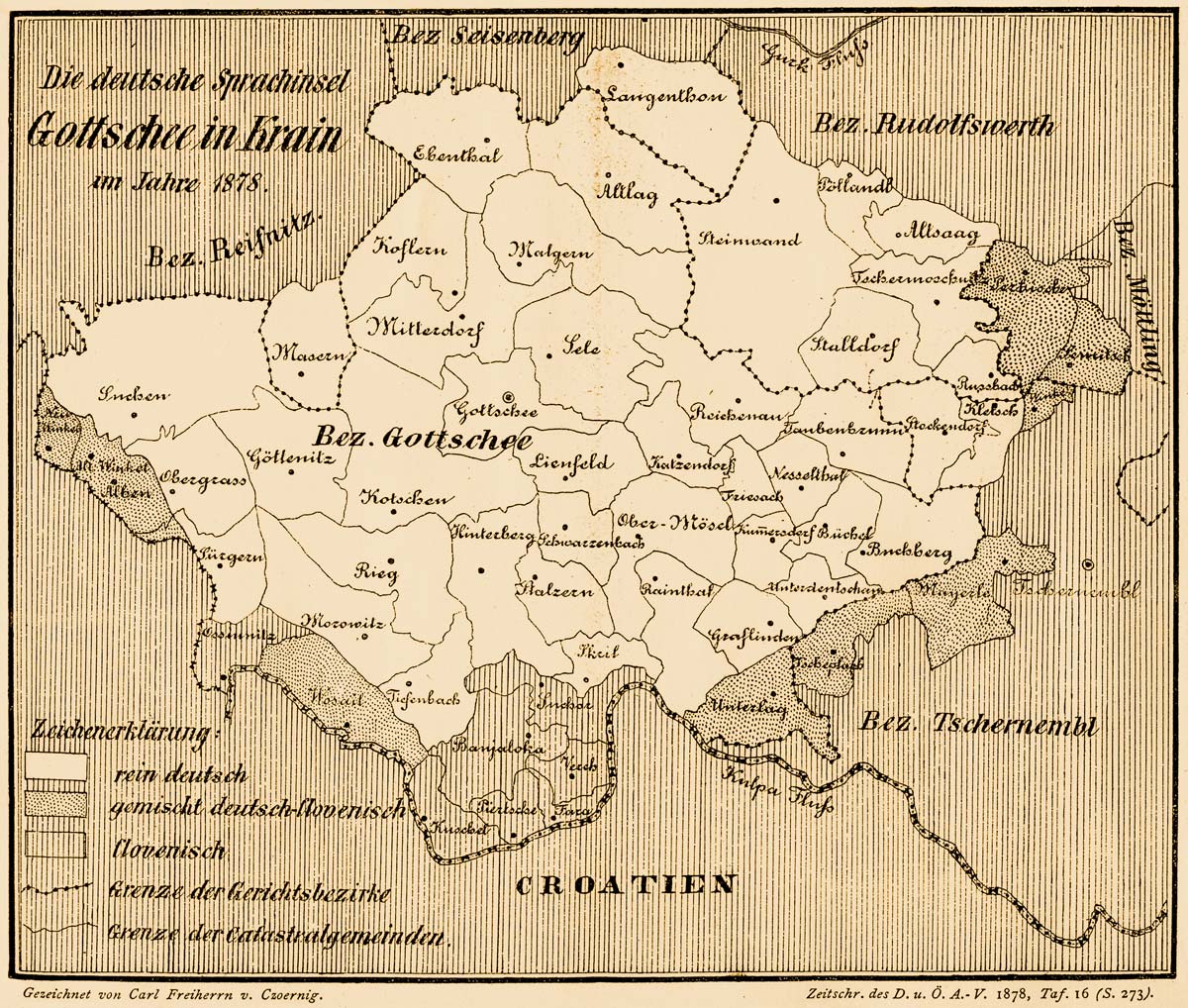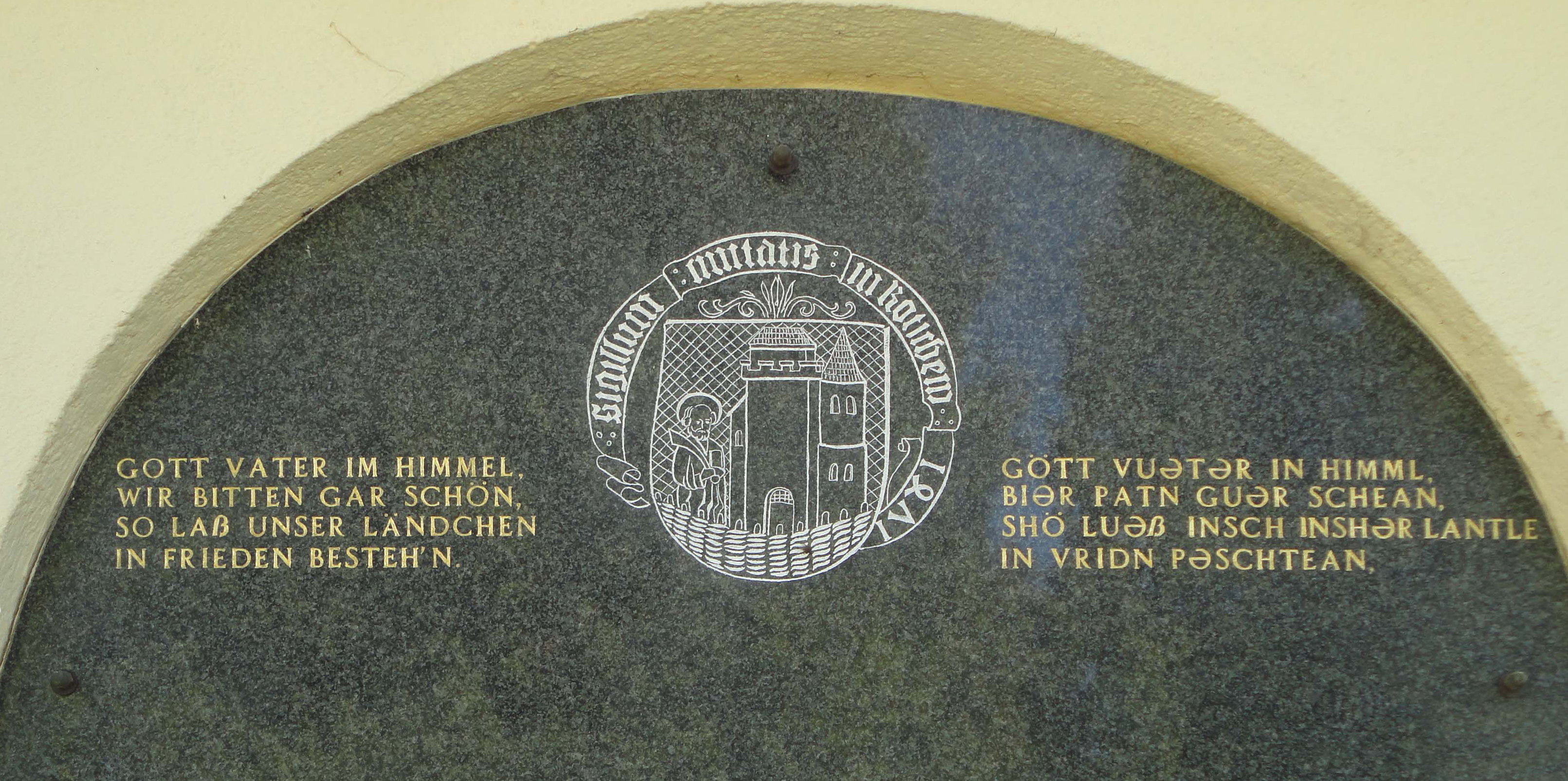|
Cvišlerji
Cvišlerji (; in older sources also ''Cvišljarji'', german: Zwischlern,''Leksikon občin kraljestev in dežel zastopanih v državnem zboru,'' vol. 6: ''Kranjsko''. 1906. Vienna: C. Kr. Dvorna in Državna Tiskarna, p. 40.Ferenc, Mitja. 2007. ''Nekdanji nemški jezikovni otok na kočevskem''. Kočevje: Pokrajinski muzej, p. 4. Gottscheerish: ''Zwishlarə'') is a settlement east of Kočevje in southern Slovenia. The area is part of the traditional region of Lower Carniola and is now included in the Southeast Slovenia Statistical Region. The settlement consists of the hamlets of Spodnji Cvišlerji ('lower Cvišlerji'), mostly containing newer houses built after the Second World War, and Zgornji Cvišlerji ('upper Cvišlerji'), containing older houses. Name Cvišlerji was recorded in the land registry of 1574 as ''Zwisslern''. The Slovene name ''Cvišlerji'' is an adaptation of German ''Zwischlern'', derived from Middle High German ''zwisele'' (= Germ. ''Zwiesel'') 'forked tree', refer ... [...More Info...] [...Related Items...] OR: [Wikipedia] [Google] [Baidu] |
Municipality Of Kočevje
The Municipality of Kočevje (; sl, Občina Kočevje) is a municipality in southern Slovenia. The seat of the municipality is the city of Kočevje. Today it is part of the Southeast Slovenia Statistical Region. In terms of area, it is the largest municipality in Slovenia. History In 1247 Berthold, Patriarch of Aquileia granted the area around Ribnica within the imperial March of Carniola to the Carinthian counts of Ortenburg. When the counts received further estates on the wooded plateau down to Kostel on the Kolpa River in 1336 from the hands of Patriarch Bertram, they called for German-speaking settlers from Carinthia and Tyrol. These Germanic people became known as the Gottscheers, and their dialect, Gottscheerish. Thousands of Gottscheers, and others, were accused of sympathy for or collaboration with the Axis Powers during World War II (such as the Slovene Home Guard), after the war. They, and typically their entire families, were summarily executed, thrown into v ... [...More Info...] [...Related Items...] OR: [Wikipedia] [Google] [Baidu] |
Gottschee County
Gottschee (, sl, Kočevsko) refers to a former German-speaking region in Carniola, a crownland of the Habsburg Empire, part of the historical and traditional region of Lower Carniola, now in Slovenia. The region has been a county, duchy, district, and municipality during various parts of its history. The term often also refers to the entire ethnolinguistic enclave regardless of administrative borders. Today Gottschee largely corresponds to the Municipality of Kočevje. The original German settlers of the region are called Gottschee Germans or Gottscheers, and their German dialect is called Gottschee German or Gottscheerish. Geography The Gottschee enclave encompassed a roughly oval-shaped area between 45° 46′ N and 45° 30′ N, and between 14° 36′ E and 15° 9′ E. Geographers divided the enclave into seven regions based on valleys (from west to east): * The Suchen Plateau () in the extreme west, with the (pre-1933) municipalities of Obergras and Suchen; * The Back ... [...More Info...] [...Related Items...] OR: [Wikipedia] [Google] [Baidu] |
Flag Of Slovenia
The national flag of Slovenia ( sl, zastava Slovenije) features three equal horizontal bands of white (top), blue, and red, with the Coat of arms of Slovenia located in the upper hoist side of the flag centered in the white and blue bands. The coat of arms is a shield with the image of Mount Triglav, Slovenia's highest peak, in white against a blue background at the center; beneath it are two wavy blue lines representing the Adriatic Sea and local rivers, and above it are three six-pointed golden stars arranged in an inverted triangle which are taken from the coat of arms of the Counts of Celje, the great Slovene dynastic house of the late 14th and early 15th centuries. The flag's colors are considered to be Pan-Slavism, Pan-Slavic, but they actually come from the Middle Ages, medieval coat of arms of the Duchy of Carniola, consisting of 3 stars, a mountain, and three colors (red, blue, yellow). crescent. The existing Slovene tricolor was raised for the first time in history duri ... [...More Info...] [...Related Items...] OR: [Wikipedia] [Google] [Baidu] |
Second World War
World War II or the Second World War, often abbreviated as WWII or WW2, was a world war that lasted from 1939 to 1945. It involved the vast majority of the world's countries—including all of the great powers—forming two opposing military alliances: the Allies and the Axis powers. World War II was a total war that directly involved more than 100 million personnel from more than 30 countries. The major participants in the war threw their entire economic, industrial, and scientific capabilities behind the war effort, blurring the distinction between civilian and military resources. Aircraft played a major role in the conflict, enabling the strategic bombing of population centres and deploying the only two nuclear weapons ever used in war. World War II was by far the deadliest conflict in human history; it resulted in 70 to 85 million fatalities, mostly among civilians. Tens of millions died due to genocides (including the Holocaust), starvation, ma ... [...More Info...] [...Related Items...] OR: [Wikipedia] [Google] [Baidu] |
Church (building)
A church, church building or church house is a building used for Christian worship services and other Christian religious activities. The earliest identified Christian church is a house church founded between 233 and 256. From the 11th through the 14th centuries, there was a wave of church construction in Western Europe. Sometimes, the word ''church'' is used by analogy for the buildings of other religions. ''Church'' is also used to describe the Christian religious community as a whole, or a body or an assembly of Christian believers around the world. In traditional Christian architecture, the plan view of a church often forms a Christian cross; the center aisle and seating representing the vertical beam with the Church architecture#Characteristics of the early Christian church building, bema and altar forming the horizontal. Towers or domes may inspire contemplation of the heavens. Modern churches have a variety of architectural styles and layouts. Some buildings designe ... [...More Info...] [...Related Items...] OR: [Wikipedia] [Google] [Baidu] |
Prekmurje
Prekmurje (; dialectically: ''Prèkmürsko'' or ''Prèkmüre''; hu, Muravidék) is a geographically, linguistically, culturally and ethnically defined region of Slovenia, settled by Slovenes and a Hungarian minority, lying between the Mur River in Slovenia and the Rába Valley (the watershed of the Rába; sl, Porabje) in the westernmost part of Hungary. It maintains certain specific linguistic, cultural and religious features that differentiate it from other Slovenian traditional regions. It covers an area of and has a population of 78,000 people. Name It is named after the Mur River, which separates it from the rest of Slovenia (a literal translation from Slovene would be ''Over-Mur'' or ''Transmurania''). In Hungarian, the region is known as ''Muravidék'', and in German as ''Übermurgebiet''. The name Prekmurje was introduced in the twentieth century, although it is derived from an older term. Before 1919, the Slovenian-inhabited lands of Vas County in the Kingdom ... [...More Info...] [...Related Items...] OR: [Wikipedia] [Google] [Baidu] |
Charles II, Archduke Of Austria
Charles II Francis of Austria (german: Karl II. Franz von Innerösterreich) (3 June 1540 – 10 July 1590) was an Archduke of Austria and ruler of Inner Austria (Styria, Carniola, Carinthia and Gorizia) from 1564. He was a member of the House of Habsburg. Biography A native of Vienna, he was the third son of Ferdinand I, Holy Roman Emperor, and Anne of Bohemia and Hungary, daughter of King Vladislaus II of Hungary and his wife Anne of Foix-Candale. In 1559 and again from 1564–1568 there were negotiations for a marriage between Charles and Elizabeth I of England. Emperor Ferdinand I expected Elizabeth to promise in the proposed marriage treaty that Charles, as her widower, would succeed her if she died childless. The negotiations dragged on until Queen Elizabeth decided that she would not marry the Archduke; religion was the main obstacle to the match,Doran pp.73–98 apart from the Queen's character. In 1563, Charles was also a suitor of Mary, Queen of Scots, with her uncle C ... [...More Info...] [...Related Items...] OR: [Wikipedia] [Google] [Baidu] |
Kočevje
Kočevje (; german: Gottschee; ''Göttscheab'' or ''Gətscheab'' in the local Gottscheerish dialect; it, Cocevie) is a city in the Municipality of Kočevje in southern Slovenia. It is the seat of the municipality. Geography The town is located at the foot of the Kočevski Rog karst plateau on the Rinža River in the historic Lower Carniola region. It is now part of the Southeast Slovenia Statistical Region. The Rinža River flows through the town. Lake Kočejve, a former open-pit coal mine, lies northeast of the town center. Climate Kočevje features a humid continental climate (''Dfb''/''Cfb''). Name Kočevje was attested in written sources in 1363 as ''Gotsche'' (and as ''Gotsew'' in 1386, ''Kotsche'' in 1425, and ''propre Koczeuiam'' in 1478). The name is derived from ''*Hvojčevje'' (from ''hvoja'' 'fir, spruce'), referring to the local vegetation. The initial ''hv-'' changed to ''k-'' under the influence of German phonology. Older discredited explanations inclu ... [...More Info...] [...Related Items...] OR: [Wikipedia] [Google] [Baidu] |
Middle High German
Middle High German (MHG; german: Mittelhochdeutsch (Mhd.)) is the term for the form of German spoken in the High Middle Ages. It is conventionally dated between 1050 and 1350, developing from Old High German and into Early New High German. High German is defined as those varieties of German which were affected by the Second Sound Shift; the Middle Low German and Middle Dutch languages spoken to the North and North West, which did not participate in this sound change, are not part of MHG. While there is no ''standard'' MHG, the prestige of the Hohenstaufen court gave rise in the late 12th century to a supra-regional literary language (') based on Swabian, an Alemannic dialect. This historical interpretation is complicated by the tendency of modern editions of MHG texts to use ''normalised'' spellings based on this variety (usually called "Classical MHG"), which make the written language appear more consistent than it actually is in the manuscripts. Scholars are uncertain as to ... [...More Info...] [...Related Items...] OR: [Wikipedia] [Google] [Baidu] |
Slovenia
Slovenia ( ; sl, Slovenija ), officially the Republic of Slovenia (Slovene: , abbr.: ''RS''), is a country in Central Europe. It is bordered by Italy to the west, Austria to the north, Hungary to the northeast, Croatia to the southeast, and the Adriatic Sea to the southwest. Slovenia is mostly mountainous and forested, covers , and has a population of 2.1 million (2,108,708 people). Slovenes constitute over 80% of the country's population. Slovene, a South Slavic language, is the official language. Slovenia has a predominantly temperate continental climate, with the exception of the Slovene Littoral and the Julian Alps. A sub-mediterranean climate reaches to the northern extensions of the Dinaric Alps that traverse the country in a northwest–southeast direction. The Julian Alps in the northwest have an alpine climate. Toward the northeastern Pannonian Basin, a continental climate is more pronounced. Ljubljana, the capital and largest city of Slovenia, is geogr ... [...More Info...] [...Related Items...] OR: [Wikipedia] [Google] [Baidu] |
Gottscheerish
Gottscheerish (''Göttscheabarisch'',Maridi Tscherne: Wörterbuch Gottscheerisch-Slowenisch. Einrichtung für die Erhaltung des Kulturerbes Nesseltal, Koprivnik/Nesseltal 2010. german: Gottscheerisch, sl, kočevarščina) is an Upper German dialect which was the main language of communication among the Gottscheers in the enclave of Gottschee, Slovenia, before 1941. It is occasionally referred to as Granish or Granisch in the United States (< German ''Krainisch'' ' Carniolan'), a term also used for Slovene. Today there are only a few speakers left in Slovenia and around the world. Language history Gottscheerish belongs to within the[...More Info...] [...Related Items...] OR: [Wikipedia] [Google] [Baidu] |









